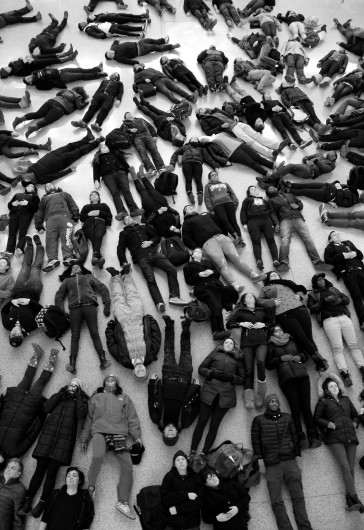
Participants lay on the ground in silence during a series of “die-out” protests that occurred around OSU’s main campus on Saturday evening, which were intended to demonstrate against police-involved deaths and racism.
Credit: Ada Matusiewicz / For The Lantern
Protesters chanted “black lives matter” and “no justice, no peace.” They entered various buildings chanting, became silent while lying down and then chanted again for about a minute before leaving, organizers said.
They gathered on Ohio State’s campus Saturday as part of a national event organized in response to recent events and legal decisions that have raised questions about police violence against members of minority groups — specifically in primarily black communities.
The protests included people lying on the ground for four and a half minutes — one minute for each hour Michael Brown’s body lay in the street after police shot him in Ferguson, Mo.
In August, Brown, an 18-year-old black man, was shot by a police officer, prompting riots in St. Louis suburbs. A grand jury brought no criminal charges against Darren Wilson, the police officer who fatally shot Brown.
About 200 people protested in the 18th Avenue Library, Thompson Library, the Oval, the Ohio Union, on High Street and outside of the South Campus Gateway Film Center from 5 p.m. to about 6:30 p.m. Saturday.
The OSU protest, called the “Oval Die-Out” on a Facebook event page, was part of a “day of action” that featured similar demonstrations occurring on college campuses throughout the nation, according to the event description.
Other events around the nation spurred Saturday’s protests.
In Cleveland, a 12-year-old boy named Tamir Rice was shot while holding an airgun outside of a recreation center in late November. The release of police surveillance footage that showed the officers pulling up to Rice and shooting him within about two seconds led to nationwide protests. Both officers involved in the shooting have been placed on administrative leave and a grand jury is set to hear the case.
In New York City, an unarmed black man named Eric Garner was killed by a police officer’s chokehold in July. Officers were looking to arrest Garner for having sold loose cigarettes. In a video of the incident, Garner can be heard saying, “I can’t breathe,” as an officer put him in a chokehold. Earlier this month, a grand jury ruled not to indict officer Daniel Pantaleo, who used the chokehold, in Garner’s death.
Morgan Johnson, a second-year in public affairs who helped organize the protest at OSU, said she had seen someone complain on the anonymous social media app, Yik Yak, that the protesters had no respect for those studying that night for finals.
“If you knew that just because you look the way that you do, you are more likely to die, or that the people you love are more likely to die, your family, your friends are more like to die, you wouldn’t say that,” she said. “Even insinuating that a final is more important than people fighting for factors for life is extremely dehumanizing.”
She added that she would be willing to explain to the student’s professor and apologize if the protest was the reason anyone failed an exam.
Kyle Strickland, a Harvard Law School student who graduated from Ohio State in 2013 and attended the protest Saturday during his winter break, said he thought the people who complained would have complained about the protests no matter what time it was.
“People were saying we’re trying to disrupt exams, but it was a silent protest,” Strickland said.
He added there was likely never going to be a perfect time to do the protest. Most of the response on social media was positive, he said.
Andrew Braun, a fourth-year in microbiology and international studies who participated in the demonstrations, said it was important to take part in the protest.
“Police brutality has been happening for a long time in minority communities,” he said. “It’s important to recognize it.”
Johnson said that while no direct talks with officials came out of the protest, she plans to petition University Police to test body cameras on officers.
“I think this is a perfect place for it, especially because Ohio State is a research institution,” she said.
University Police spokesman Dan Hedman said in an emailed statement Wednesday morning the department would “continue to evaluate and consider any technology or measures that will increase officer safety and maintain a level of trust and support which we already enjoy within the university community.”
Johnson also said she would like to sit down with the University Police chief and discuss the issue to ensure something similar to Ferguson does not happen on OSU’s campus.
Hedman said the police force supports the community’s right to protest and, when notified in advance, works with event organizers to ensure everyone involved remains safe.
Johnson and Strickland both said they wanted students to come away from the event realizing that race is something that should be openly talked about.
“The most important thing to take away is this is a difficult conversation, but what is important is that we have a discussion about the injustices in the country,” Strickland said. “We may not agree on the scope of injustices, but in general, we need to come up with solutions (for) justice in this country.”


